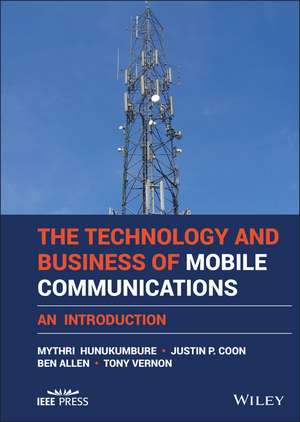The Technology and Business of Mobile Communications – An Introduction: IEEE Press
Autor M Hunukumbureen Limba Engleză Hardback – 22 dec 2021
In The Technology and Business of Mobile Telecommunications: An Introduction, a team of expert telecommunications researchers and consultants delivers a rigorous exploration of the technical and business aspects of mobile telecommunications. The book offers a complete overview of an industry that has seen rapid technical and economic changes while retaining the ability to provide end users with communications coverage and capacity.
The authors demonstrate the technical foundations of the mobile industry and show how a communications network is deployed. They detail many of the main innovations introduced over the last few years and some of the most salient challenges facing the industry today. The business models of major mobile operators are examined as well, from the purchasing spectrum to network deployment and customer attraction and retention.
The role of the regulator is also thoroughly discussed, with explorations of its role in encouraging the maintenance of a competitive market in which the needs of consumers are met.
Readers will also enjoy:
- Thorough introductions to the social and economic impacts of mobile communications, as well as a brief history of mobile and cellular communications
- Comprehensive explorations of the mobile telecoms ecosystem, from spectrum regulation to standardization, research, end users, operators, vendors, and standard bodies
- Practical discussions of the business models and challenges of mobile operators, including mobile virtual network operators and the implementation of international roaming
- In-depth examinations of telecommunications standards, including 5G
Din seria IEEE Press
- 5%
 Preț: 599.39 lei
Preț: 599.39 lei - 20%
 Preț: 684.17 lei
Preț: 684.17 lei - 24%
 Preț: 667.15 lei
Preț: 667.15 lei - 24%
 Preț: 1226.95 lei
Preț: 1226.95 lei - 24%
 Preț: 707.88 lei
Preț: 707.88 lei - 24%
 Preț: 702.63 lei
Preț: 702.63 lei - 24%
 Preț: 617.46 lei
Preț: 617.46 lei - 24%
 Preț: 600.44 lei
Preț: 600.44 lei - 24%
 Preț: 741.54 lei
Preț: 741.54 lei - 24%
 Preț: 706.13 lei
Preț: 706.13 lei - 24%
 Preț: 704.88 lei
Preț: 704.88 lei - 24%
 Preț: 695.87 lei
Preț: 695.87 lei - 24%
 Preț: 618.99 lei
Preț: 618.99 lei - 24%
 Preț: 546.25 lei
Preț: 546.25 lei - 14%
 Preț: 858.78 lei
Preț: 858.78 lei - 20%
 Preț: 446.58 lei
Preț: 446.58 lei - 24%
 Preț: 672.04 lei
Preț: 672.04 lei - 24%
 Preț: 612.66 lei
Preț: 612.66 lei - 24%
 Preț: 572.10 lei
Preț: 572.10 lei - 14%
 Preț: 743.46 lei
Preț: 743.46 lei - 23%
 Preț: 1031.28 lei
Preț: 1031.28 lei -
 Preț: 415.98 lei
Preț: 415.98 lei - 9%
 Preț: 1010.21 lei
Preț: 1010.21 lei - 9%
 Preț: 1499.89 lei
Preț: 1499.89 lei - 9%
 Preț: 806.07 lei
Preț: 806.07 lei - 9%
 Preț: 1069.47 lei
Preț: 1069.47 lei - 9%
 Preț: 1117.45 lei
Preț: 1117.45 lei - 20%
 Preț: 723.20 lei
Preț: 723.20 lei - 9%
 Preț: 923.82 lei
Preț: 923.82 lei - 9%
 Preț: 994.01 lei
Preț: 994.01 lei - 9%
 Preț: 963.51 lei
Preț: 963.51 lei - 9%
 Preț: 1969.97 lei
Preț: 1969.97 lei - 9%
 Preț: 1021.22 lei
Preț: 1021.22 lei - 9%
 Preț: 742.90 lei
Preț: 742.90 lei - 9%
 Preț: 1485.82 lei
Preț: 1485.82 lei - 9%
 Preț: 1020.25 lei
Preț: 1020.25 lei - 9%
 Preț: 930.31 lei
Preț: 930.31 lei - 9%
 Preț: 997.70 lei
Preț: 997.70 lei - 9%
 Preț: 970.56 lei
Preț: 970.56 lei - 9%
 Preț: 781.15 lei
Preț: 781.15 lei - 9%
 Preț: 1162.23 lei
Preț: 1162.23 lei - 9%
 Preț: 1030.34 lei
Preț: 1030.34 lei - 9%
 Preț: 815.85 lei
Preț: 815.85 lei - 9%
 Preț: 1130.31 lei
Preț: 1130.31 lei - 9%
 Preț: 1560.74 lei
Preț: 1560.74 lei - 9%
 Preț: 1289.30 lei
Preț: 1289.30 lei - 9%
 Preț: 1036.75 lei
Preț: 1036.75 lei - 9%
 Preț: 968.96 lei
Preț: 968.96 lei - 9%
 Preț: 1130.63 lei
Preț: 1130.63 lei - 9%
 Preț: 1010.82 lei
Preț: 1010.82 lei
Preț: 626.34 lei
Preț vechi: 680.80 lei
-8% Nou
Puncte Express: 940
Preț estimativ în valută:
119.89€ • 130.27$ • 100.77£
119.89€ • 130.27$ • 100.77£
Carte tipărită la comandă
Livrare economică 21 aprilie-05 mai
Preluare comenzi: 021 569.72.76
Specificații
ISBN-13: 9781119130291
ISBN-10: 1119130298
Pagini: 448
Dimensiuni: 176 x 246 x 32 mm
Greutate: 0.9 kg
Editura: Wiley
Seria IEEE Press
Locul publicării:Chichester, United Kingdom
ISBN-10: 1119130298
Pagini: 448
Dimensiuni: 176 x 246 x 32 mm
Greutate: 0.9 kg
Editura: Wiley
Seria IEEE Press
Locul publicării:Chichester, United Kingdom
Cuprins
Foreword xv
Preface xvii
About the Authors xix
Acknowledgements xxi
List of Abbreviations xxiii
1 A Technology that Changed the World 1
1.1 Social and Economic Impact of Mobile Communications 2
1.1.1 Social Impact 3
1.1.2 Economic Impact 5
1.2 A Brief History of Mobile (Cellular) Communications 8
1.3 The Journey of Mobile Communications as Seen from User and Operator Perspectives 18
References 20
2 The Mobile Telecoms Ecosystem 23
2.1 Introduction 23
2.2 Telecommunications Ecosystem 24
2.3 Regulation and Spectrum 26
2.3 Standardisation 27
2.4 Research 28
2.5 End Users 30
2.6 The Role of Operators (Carriers) 30
2.7 The Role of Vendors/Manufacturers 31
2.8 The Role of Standard Bodies and Regulators 31
2.9 Telecoms Ecosystem Dynamics and Behaviour 32
2.10 5G Ecosystem 35
2.10.1 Datacentres 36
2.10.2 RF Chip and Component Manufacturers 36
2.10.3 Telecom Operators (Carriers) 36
2.10.4 Infrastructure Service Providers 36
2.10.5 Gaming 37
2.10.6 Over The Top (OTT) 37
2.10.7 Low-Cost Processing Unit Manufacturer 37
2.10.8 Investors 38
2.10.9 Potential Disruptions in the 5G EcoSystem 38
2.11 Summary 41
References 41
3 The Business of a Mobile Operator 43
3.1 Business Challenges Faced by Operators 43
3.1.1 Third-Party Costs 43
3.1.2 Radio Access Network Costs 45
3.1.3 Transmission Costs 49
3.1.4 Physical Locations 53
3.1.5 Power Costs for Multiple Technologies 54
3.2 MVNOs - Mobile Virtual Network Operators 56
3.2.1 Economics of an MVNO 57
3.2.2 Modelling MVNOs and SPs 59
3.3 Operator Business around International Roaming 63
3.3.1 The EU Roaming Regulation 'Roam like at Home' 64
3.3.2 Covid-19 Impact on Roaming Revenues 66
3.4 The Likely Operator Business Models in 5G 66
3.5 Conclusion 69
References 69
4 Why Standards Matter 73
4.1 The Creation of a New 'G' 74
4.1.1 Research 74
4.1.2 Standardisation 75
4.1.3 Commercialisation 77
4.1.4 Continued Innovation 79
4.1.5 Intellectual Property as a Metric and Political Currency 81
4.2 Shifting Political Power and the Making of an Ecosystem 81
4.2.1 2G GSM - Europe Leads 82
4.2.2 3G UMTS - Universal (Except Not Quite) 85
4.2.3 4G EPS - Avoiding Old Mistakes (and Making New Ones?) 89
4.2.4 5G NR - New World Order? 94
4.3 Future Standards 97
References 99
5 The Mobile Network 101
5.1 Mobile Network Architecture 101
5.2 The Radio Access Network (RAN) 103
5.2.1 Synchronisation 104
5.2.2 Broadcast Messages 104
5.2.3 Paging 104
5.2.4 Random Access 105
5.2.5 Scheduling 105
5.2.6 Power Control 106
5.2.7 Handover 106
5.2.8 Link Adaptation 108
5.2.9 HARQ, Error Correction 108
5.2.10 MIMO Techniques 109
5.2.11 The Control/data Channels and Reference Signals 109
5.3 The Core Network (CN) 110
5.3.1 Circuit Switching and Packet Switching Networks 110
5.3.2 Tunnelling and Encapsulation 111
5.4 The Protocol Stack 112
5.4.1 The OSI Model of 7 Layer Protocol Stack 113
5.4.2 Protocol Stacks for Mobile Communications 115
5.5 The 2G Network 118
5.5.1 The Network Architecture of 2G 118
5.5.2 The GSM Frame Structure 120
5.5.3 GSM (And GPRS) RAN Features 122
5.5.4 2G Evolutions 124
5.6 The 3G Network 124
5.6.1 The UMTS Terrestrial Radio Access Network (UTRAN) 125
5.6.2 UTRAN Features 129
5.6.3 The IP Multimedia Subsystem (IMS) 130
5.6.4 Issues with the UMTS Air Interface 131
5.6.5 3G Evolution to HSPA 132
5.7 The 4G Network 133
5.7.1 LTE System Architecture 134
5.7.2 LTE Protocol Layers 136
5.7.3 LTE Multiple Access Schemes 139
5.7.4 LTE Frame Structures 142
5.7.5 LTE Reference Signals 144
5.7.6 LTE main RAN procedures 144
5.7.7 Main Features of Subsequent LTE Releases 148
5.8 The 5G Network 150
5.8.1 5G-NR Deployment Options 152
5.8.2 5G-NR System Architecture 153
5.8.3 Spectrum Options for 5G-NR 154
5.8.4 5G-NR Protocol Layers 155
5.8.5 The 5G-NR Air Interface 158
5.8.6 5G-NR RAN procedures 160
5.8.7 5G-NR Reference Signals 161
5.8.8 5G Core - Concepts and Functionalities 162
5.9 The Centralisation and Virtualisation of the Mobile Network 163
5.9.1 The Centralised RAN (C-RAN) 164
5.9.2 NFV (Virtualised Network Functions) and SDN (Software Defined Networking) Concepts 166
5.10 Conclusions 169
References 170
6 Basics of Network Dimensioning and Planning 173
6.1 Properties of Signal Strength, Noise and Interference 174
6.2 The Link Budget and Coverage Dimensioning 178
6.2.1 The Transmit Power 178
6.2.2 The Antenna Gains 178
6.2.3 Transmit and Receive Diversity Gains 179
6.2.4 The EIRP 179
6.2.5 Modelling the Path Loss 180
6.2.6 Modelling the Log Normal Fade Margin 183
6.2.7 The FFM 184
6.2.8 Building Penetration Loss 185
6.2.9 Building the Link Budget 185
6.3 Capacity Dimensioning 187
6.3.1 The Capacity Demand Estimation Process 188
6.3.2 Capacity Demand Estimation - Worked Example 189
6.3.3 Resource Provision - Worked Example 194
6.4 The Dimensioning of Backhaul Links 199
6.4.1 LTE Backhaul Provision - General Aspects 200
6.4.2 LTE Backhaul Provision - Capacity Aspects 201
6.4.3 New Developments in Backhaul/fronthaul Provision 207
6.5 The Network Planning Process 208
6.5.1 The Network Area Maps 208
6.5.2 Site Placement and Antenna Radiation Patterns 209
6.5.3 Traffic Modelling and Capacity Provision Information 210
6.5.4 Fine Tuning and Optimisation 212
6.6 A Look at 5G Networks 213
References 216
7 Spectrum - The Life Blood of Radio Communications 219
7.1 Introduction 219
7.2 Spectrum Management and Its Objectives 219
7.2.1 The Role of the ITU 220
7.2.2 Regional Bodies 221
7.2.3 National Regulators and Their Roles 222
7.2.4 The Spectrum Management Process 223
7.3 Spectrum Allocations 225
7.4 Spectrum Assignment 225
7.4.1 Administrative Assignments 226
7.4.2 Market Based Mechanisms 226
7.4.3 Beauty Contests 227
7.5 Spectrum Licensing 228
7.5.1 Spectrum for Mobile Services 228
7.5.2 Dimensions of Spectrum Sharing 233
7.6 Spectrum Bands Considered for 5G 235
7.6.1 Example Illustration of Spectrum Deployment Strategy for MNOs 236
7.6.2 Local Access Spectrum 237
References 238
8 Fundamentals of Digital Communication 241
8.1 Basic Digital Communication System Overview 241
8.2 Encoding Information 243
8.2.1 Sampling 243
8.2.2 Source Coding 245
8.2.3 Channel Coding 246
8.3 Signal Representation and Modulation 251
8.3.1 Mapping Bits to Signals 253
8.3.2 Signal Spectrum 256
8.4 Signal Demodulation and Detection 257
8.4.1 System Model and Sources of Noise 257
8.4.2 Demodulation 258
8.4.3 Detection 260
8.5 Performance Analysis 260
8.5.1 Capacity 260
8.5.2 Bit-error Rate and Symbol-error Rate 262
8.6 Communication Through Dispersive Channels 264
8.6.1 Time-domain Equalization and Detection 264
8.6.2 Frequency-domain Equalisation 267
8.7 Multiple Access: A Second Look 272
8.7.1 CDMA and 3G 272
8.7.2 OFDMA/SC-FDMA and 4G 275
8.7.3 NOMA and 5G 277
8.8 System Impairments 278
8.8.1 Carrier Phase Estimation 279
8.8.2 Timing Recovery 280
8.8.3 Channel Estimation 280
8.9 Further Reading 282
Notes 282
References 283
9 Early Technical Challenges and Innovative Solutions 285
9.1 Wireless Channels: The Challenge 285
9.1.1 Propagation 285
9.1.2 Fading and Multipath 287
9.1.3 Signal-to-Noise Ratio in Fading Channels 293
9.2 Multicarrier Modulation: A Second Look 295
9.2.1 Coded OFDM 295
9.2.2 Capacity and Adaptive Modulation 295
9.3 Diversity 297
9.3.1 Macro Diversity 297
9.3.2 Time Diversity 298
9.3.3 Frequency Diversity 300
9.3.4 Spatial Diversity 300
9.4 Multiple Input Multiple Output (MIMO) 307
9.4.1 Capacity 308
9.4.2 MIMO Transmission Techniques 309
9.4.3 MIMO Reception Techniques 311
9.4.4 MIMO vs Multicarrier 312
9.4.5 Multi-User and Massive MIMO 313
References 315
10 Small Cells - an Evolution or a Revolution? 317
10.1 Introduction 317
10.2 Small Cells Concept Formation 319
10.3 Multi-tier Cellular Networks/HetNets Architecture 320
10.3.1 Interference Management 320
10.3.2 Mobility Management 321
10.3.3 Backhaul 322
10.4 Interference Management and Modelling in Small cell/HetNets 322
10.4.1 Interference Management 322
10.4.2 Interference Modelling 325
10.5 Mobility Management 329
10.6 Backhaul 332
10.7 Small-Cell Deployment 335
10.8 Future Evolution of Small Cells 339
10.9 Conclusion 342
References 342
11 Today's and Tomorrow's Challenges 345
11.1 The Capacity Crunch 345
11.1.1 A Historical Perspective 345
11.1.2 Methods for Capacity Enhancement 346
11.1.3 Impact on Transport and Core Networks 349
11.1.4 Complementary Technologies 352
11.2 Increasing Network Complexity 354
11.2.1 The Self-Organising Networks 355
11.2.2 Network Automation in 5G 359
11.2.3 The Business Rationale for Network Automation 361
11.3 The Need for Greener and Lower EMF Networks 362
11.3.1 Greener Mobile Networks 362
11.3.3 Green Manufacturing and Recycling 364
11.3.4 Applications of Mobile Networks for Energy Reduction 364
11.3.5 Electromagnetic Field Exposure and Mobile Networks 365
11.4 Covering the Unserved and Under-served Regions 368
11.4.1 New Access Technologies 368
11.4.2 Initiatives Driven by Government Funding and Policy 371
Reference 373
12 The Changing Face of Mobile Communications 377
12.1 Changes with Centralisation and Virtualisation of the Mobile Network 377
12.2 Supporting Multiple Vertical Industries through 5G 380
12.2.1 Automotive Sector 380
12.2.2 Smart City 383
12.2.3 Industry 4.0 386
12.2.4 Critical Communications Sector 388
12.2.5 Other Vertical Areas under Development 391
12.3 The Continuous Evolution of the Mobile Device 393
12.4 What Will 6G Look Like? 395
12.4.1 Machine Learning and Artificial Intelligence 395
12.4.2 Blockchain and the Internet of Things 396
12.4.3 Evolutions in Cloud and Edge Computing 397
12.4.4 Advanced Hybrid Beamforming 398
12.4.5 New Modulation Schemes 399
12.4.6 Tera-Hertz (Thz) Communications 399
12.4.7 Orbital Angular Momentum 401
12.4.8 Unmanned Aerial Vehicles 401
12.4.9 Quantum Technology 401
References 402
Index 407
Notă biografică
Mythri Hunukumbure earned his PhD degree in Telecommunication Engineering from the University of Bristol in 2004. He is currently a Principal Research Engineer and a Project Lead at Samsung Electronics R&D Institute UK. He has contributed to and later led mobile communication research, standardisation, and product development activities. While at Samsung, he has participated in flagship EU projects mmMAGIC, ONE5G and 5G LOCUS as a work package leader. He is actively contributing to 3GPP RAN1 and SA2 standardisation topics, securing vital IPR. He has filed around 50 patents to date and has also published extensively in leading conferences and journals, receiving the best paper award at the World Telecommunications Congress (WTC) in 2012. Justin P. Coon received his PhD in Communications from the University of Bristol, UK in 2005. From 2004 until 2013, he held various technical and management positions at Toshiba Research Europe Ltd. (TREL). Professor Coon also held a Reader position in the Department of Electrical and Electronic Engineering at the University of Bristol from 2012 until 2013. In 2013, he took a faculty position at Oxford University with a Tutorial Fellowship at Oriel College. Professor Coon is a Fellow of the Institute of Mathematics and Its Applications (FIMA) and a Senior Member of the Institute of Electrical and Electronics Engineers (IEEE). Ben Allen completed his PhD degree at the University of Bristol in 2001. He completed a Royal Society Industry Fellowship with the University of Oxford and Network Rail, and has led several R&D activities involving telecoms for railways, several of which exhibit state-of-the-art advances. He is now working in the satellite communications industry. He has published numerous papers and several books on radio and telecommunications research developments. Dr Allen is a Chartered Engineer, Fellow of the Institution of Engineering & Technology, Institute of Telecommunications Professionals and the Higher Education Academy. Tony Vernon graduated from the University of Glasgow, UK, in 1987 with a Joint Honours in Electronic Engineering with Physics. After a few years in the cellular industry, he obtained chartered status and in 2002 received a PhD in Mobile Telecoms from the University of Bristol, UK. His main interests and career contributions lie in the planning and optimisation of digital mobile networks ranging from the dawn of 2G in 1991 to 5G in 2021. Dr Vernon's focus has moved to the vehicular channel (V2X) and the future use of soon-to-be-ubiquitous mobile broadband networks for national and public-access broadcasting. He is based on the Scottish Outer Hebridean island of South Uist and is passionate about expanding 4G and 5G mobile broadband connectivity to rural and remote areas.


